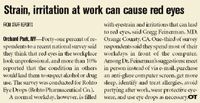Article
Can't live with them, can't live without them
There are three types of employees: climbers, quitters, and some who camp at mediocrity. Practice administrators who get to know their employees and what makes them tick will contribute to the success of the practice. It may be a matter of uncovering his or her true talents and finding the right place for that person within the practice.

Key Points
San Diego-We're talking employees-the mediocre campers, the fast-moving climbers, and the disgruntled quitters who just won't quit. Polly Neely, a Thorofare, NJ-based sales and marketing manager, addressed the different types of employees in a talk to the American Society of Ophthalmic Administrators.
"Business is about people. Good bosses never forget their people-the employees who do them right," she said. But employers also need to think about those good and loyal employees who are "horrible at what they do," she added.

"Your employees . . . own their jobs, they own those positions," Neely said. "Do you empower them? They need to know they own them. There's pride in ownership."
One obstacle to employees owning their jobs is the "Chester" administrator-people who have to do everything themselves under the assumption that it won't be done right otherwise. Neely said the practice makes the Chester administrator unhappy and doesn't encourage employees to complete tasks correctly next time.
"Be a 'letter' and let employees fail," Neely said. "Give them enough rope to hang themselves or let them swing happily. Employees need your encouragement, motivation, and empowerment."
Neely said there are three types of employees: campers, quitters, and climbers.
Campers are OK with what they're doing and are generally well liked; they are mediocre employees but don't cause any problems.
"They know they're not going to climb the ladder," Neely said. "They pitch their tents and ain't moving. They're squatters."
Climbers, on the other hand, are sponges, grabbing everything that comes in and putting it to use. They are moving up the chain fast and comprise about 20% of a practice.
On the opposite side of the fence are quitters, people who cause so many problems but just won't go away. Neely said that quitters usually stay until they are forced to leave. By then, they have completely alienated everyone around them.
"Why do we keep those people? Because they are bodies," Neely said. "A warm body is not better than no body. Who in your practice do you think is doing the quitter's job? You and the other 20%."
Neely likened quitters to something in the road you keep going around instead of getting out of the car and moving it. "You have to understand, your dead weight is killing you," she said.
Administrators, she suggested, need to get to know their employees and what makes them tick on the job. She suggests meeting one-on-one monthly for 5 to 10 minutes with each staff member to talk about how things are going, ask for suggestions on making him or her happier, and head problems off at the pass.
"It makes such a difference for employees to have that one-on-one with you," Neely said. "It's cut and dried, in and out, but it gives you a chance to get to know the employees. And having that time with you every month cuts down on employees coming to you every day with the little stuff."




